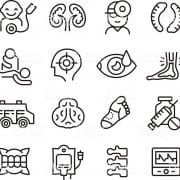Branches of medicine
Branches of medicine – Anatomy: This is the study of the physical structure of the body.
Branches of medicine – Biochemistry: A biochemist studies chemical components and how they affect the body.
Branches of medicine – Biomechanics: This focuses on the structure of biological systems in the body and how they work, using a mechanical approach.
Branches of medicine – Biostatistics: Researchers apply statistics to biological fields. This is crucial for successful medical research and many areas of medical practice.
Biophysics: This uses physics, mathematics, chemistry, and biology to model and understands the workings of biological systems.
Cytology: This is a branch of pathology that involves the medical and scientific microscopic study of cells.
Embryology: This branch of biology studies the formation, early growth, and development of organisms.
Endocrinology: Scientists investigate hormones and their impact on the body.
Epidemiology: Researchers track the causes, distribution, and control of diseases in populations.
Genetics: This is the study of genes and their impact on health and the body.
Histology: This involves looking at the form of structures under the microscope. It is also known as microscopic anatomy.
Microbiology: This is the study of organisms that are too small to see with the naked eye, known as microorganisms. Aspects of microbiology include bacteriology, virology, mycology (the study of fungi), and parasitology.
Neuroscience: Neuroscientists study the nervous system and the brain and investigate diseases of the nervous system. Aspects of neuroscience include computational modeling and psychophysics. Some types of neuroscience are cognitive neuroscience, cellular neuroscience, and molecular neuroscience.
Nutrition: Nutritionists study how food and drink influence health, and how they can help treat, cure, and prevent different diseases and conditions.
Pathology: This is the study of disease. A pathologist often works in a laboratory, where they do tests — usually on a sample of blood, urine, or body tissue — to help diagnose diseases and conditions.
Pharmacology: This involves the study of pharmaceutical medications, or drugs, where they come from, how they work, how the body responds to them, and what they consist of.
Radiology: Radiologists use X-rays and scanning equipment during the diagnostic procedure, and sometimes as part of treatment, too.
Toxicology: A toxicologist studies poisons, what they are, what effects they have on the body, and how to detect them.
These are not all the aspects and fields of medicine. Many people work in patient transportation, dentistry, not to mention the many different specialties that physicians can choose to follow, such as emergency medicine.
For anyone who is considering medicine as a career, there are a wide variety of options.
UNIVERSITIES OF MEDICINE
&
TUITION FEES
Comenius Medical University in Bratislava, Slovakia
Entrance exam: Biology and Chemistry
Safarik Medical University in Kosice, Slovakia
10,500 euro per year
Entrance exam: Biology and Chemistry
Jessenius Medical University in Marin, Slovakia
9,500 euro per year
Entrance exam: Biology and Chemistry
Carol Davila University of Medicine in Bucharest, Romania
6,000 euro per year
Entrance exam: English language evaluation
Iuliu Hațieganu University of Medicine in Cluj, Romania
6,000 euro per year
Entrance exam: English language evaluation
Gr.T. Popa Medical University in Iasi, Romania
5,000 euro per year
Entrance exam: English language evaluation
Ovidius Medical University in Constanza, Romania
5,000 euro per year
Entrance exam: English language evaluation
Victor Babes University of Medicine in Timisoara, Romania
5,000 per year
Entrance exam: Biology and English language evaluation
Medical University of Sofia in Sofia, Bulgaria
8,000 euro per year
Entrance exam: Biology, Chemistry and English Language evaluation
Medical University of Varna in Varna, Bulgaria
8,000 euro per year
Entrance exam: Biology, Chemistry and English Language evaluation
Medical University of Plovdiv in Plovdiv, Bulgaria
8,000 euro per year
Entrance exam: Biology, Chemistry and English Language evaluation
Medical University of Novi Sad in Novi Sad, Serbia
5,500 euro per year
Entrance exam: Biology, Chemistry and English Language evaluation
Semmelweis University of Medicine in Budapest, Hungary
18,200 USD per year
Entrance exam: Biology and Chemistry
University of Medicine in Szeged, Hungary
16,520 USD per year
Entrance exam: Biology and Chemistry
University of Medicine in Pecs, Hungary
15,700 USD per year
Entrance exam: Biology and Chemistry
Medical University of Vienna in Vienna, Austria
FREE
Charles University of Medicine in Prague, Czech Republic
13,300 euro per year
Entrance exam: Biology, Chemistry, Physics and English Language evaluation
University of Medicine in Belgrade, Serbia
7,000 USD per year
Entrance exam: Biology and Chemistry
Palacky University of Medicine in Olomouc, Czech Republic
10,000 euro per year
Entrance exam: Biology, Chemistry, Physics and English Language evaluation
Ostrava University of Medicine in Ostrava, Czech Republic
8,000 euro per year
Entrance exam: Biology, Chemistry, Physics and English Language evaluation




